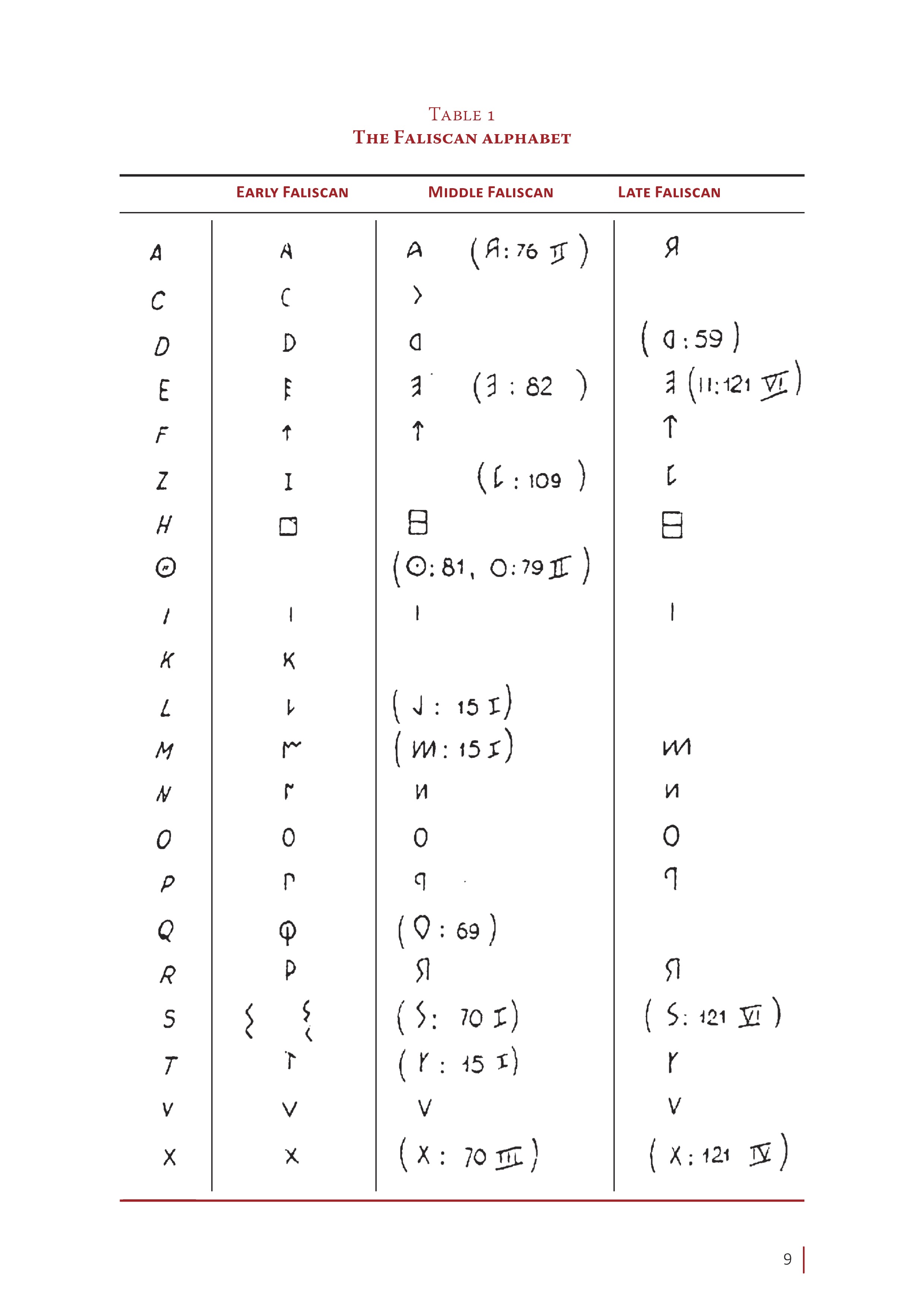The Faliscan Alphabet
Faliscan inscriptions almost exclusively use an epichoric alphabet, which differs from all the other alphabets of Ancient Italy. This alphabet is essentially unitary, despite some minor changes in the shape of the letters and in the orthographic conventions over the centuries.
The Faliscan alphabet is to be regarded as an evolution of a southern Etruscan alphabet. In particular, the derivation from an Etruscan alphabet is ensured by the use in the Early Faliscan inscriptions of an orthographic convention which is common to the Etruscan and Latin early inscriptions. According to this convention, the Greek letters gamma (g), kappa (k), and qoppa (q), originally corresponding to [g],
[k], and an allophone of [k] before back vowels respectively, are used as signs for velar stops, regardless of sonority (both for [k] and [g]), on the basis of the following vowel. Commonly, g is used before front vowels ([e], [i]), k before /a/, and q before back vowels ([o], [u]). Whatever the reason for using such an orthographic convention, it is evident that it can only have arisen in an Etruscan-speaking environment, because of the lack of graphic distinction between voiced (/g/) and voiceless (/k/) velar stops. Indeed, such a distinction, phonologically relevant to Faliscan and Latin, was absent in the Etruscan phonemic inventory. Furthermore, the use of a four-bar sigma in the Early Faliscan inscriptions may suggest a specific Veientan influence on the Faliscan alphabet.
The Faliscan alphabet also includes letters not used in the Etruscan alphabet, such as o, d, and possibly b, which have survived in the Etruscan scribes’ overall competence, also if they were not used for writing Etruscan texts. Furthermore, in some Faliscan inscriptions theta (θ) is used, probably due to interference with the Etruscan writing.
The arrow shape of f (↑), which probably stands for a voiceless bilabial/labiodental fricative, is one of the distinctive features of the Faliscan alphabet, already in the earliest inscriptions. Nevertheless, its presence in a Sabellian inscription of the 6th century BC from the Ferrone necropolis, in a territory under the control of the Etruscan city of Caere, as well as, possibly, in a partial alphabetary of the end of the 6th century BC from Nola and in an inscription of the second half of the 5th century BC from Rimini entails assuming that, originally, its use was more widespread.
Earlier inscriptions are commonly in scriptio continua. In two Early Faliscan inscriptions we find a punctuation mark consisting of three vertically aligned dots with an uncertain function, partly used – at least apparently – in correspondence with boundaries between syntactic units. In later texts, words are usually separated by interpuncts, although with some inconsistencies. Earlier and later inscriptions also differ in the direction of the writing, which changed from left-to-right to right-to-left during the 6th century BC.
Faliscan alphabet seems to be exceptionally used for writing Etruscan in an inscription painted on a tile from a tomb near Rignano Flaminio (Bakkum XLIII). Several inscriptions coming from the Faliscan territory are written in the Roman alphabet but are not immediately identifiable as Faliscan or dialectal Latin because of the lack of distinctive linguistic features.

Bibliography:
- G. C. L. Bakkum, 2009. The Latin Dialect of the Ager Faliscus, Amsterdam.
- V. Bellelli, 2002. «Nola», Studi Etruschi 65-68, pp. 372-375.
- G. Giacomelli, 1963. La lingua falisca, Firenze.
- M. Mancini, 2008. «Scritture e lingue nel Lazio protostorico e nell’Ager Faliscus: un bilancio», AIΩN 30/III, pp. 193-207.
- M. Pandolfini, A. L. Prosdocimi, 1990. Alfabetari e insegnamento della scrittura in Etruria e nell’Italia antica, Firenze.
- E. Peruzzi, 1964. «Etruschi a Corchiano», La Parola del Passato 19, pp. 227-232.
- A. L. Prosdocimi, 1990. «Vetter 243 e l’imperativo latino. Tra (con)testo e paradigma», in G. Maetzke, O. Paoletti, L. Tamagno Perna (eds.), La Civiltà dei Falisci, Firenze, pp. 291-326.
- L. Rigobianco, 2020. «Falisco», Palaeohispanica 20, pp. 299-333.
- R. Wachter, 1987. Altlateinische Inschriften, Bern-Frankfurt am Main – New York – Paris.
Last update
10.04.2024
